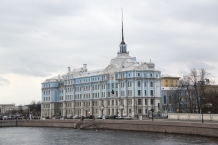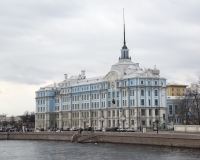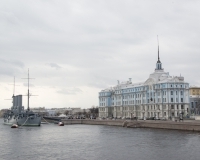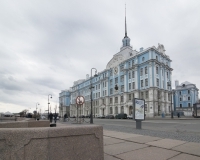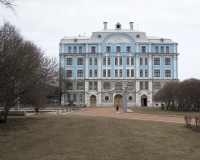Peter the Great City College House (Nakhimov Naval School)
The building of the Peter the Great City College House was originally designed to be a sort of monument to the founder of St. Petersburg. In 1902, the City Duma included building a “people’s school house” in the program of celebrations of Peter’s 200th anniversary as a monument to Peter I who “cared about the education of the Russian people”. The foundation stone was laid in the spring of 1903. A construction site was chosen not far away from the Cabin of Peter I.
A design competition took place in the spring of 1905. The main part of the facility was supposed to accommodate twelve classrooms of primary schools and four-year colleges for male and female students, a free-admission reading room, and a trade school with classrooms and workshops in a separate building. According to the competition program, a sculptural portrait of Peter was to be placed on the façade.
The first prize was given to the design by Alexander Dmitriev (1878-1959). The construction began in 1909. The building was completed by the autumn of 1910, and finishing work continued for another year. A trade school was opened in the beginning of 1912. On May 30, 1912, the complex of the College House was consecrated to commemorate the 240th anniversary of the birth of Peter I.
The main longitudinal building facing the Bolshaya Nevka River is pronouncedly asymmetrical. The memorial nature of the building dedicated to the founder of St. Petersburg is underlined by a wide use of techniques from Petrine Baroque style, such as high hipped roofs, rusted lesenes and pilasters, and divided-light windows. The architectural decorations are effectively highlighted by whitewashed elements against the background of the blue walls. A superstructure with a spire topped with a wind vane in the shape of a galley rises above the rounded pediment. A bronze bust of Peter I wearing the armor and a robe trimmed with ermine is placed in a niche at the level of the third floor. The bust of Peter above the main entrance and the reliefs on the facades were made by sculptor Vladimir Kuznetsov with the participation of Alexander Kudinov and Natalia Dan’ko. The bust was cast in the studio of Vasily Gavrilov. The niche surrounded by rich patterned plaster decorations with a cartouche and an inscription reading “To the Father of the Fatherland”. The tympan of the pediment has a high-relief composition with Peter I’s monogram under a crown and figures of young men carrying a flowing lion’s skin which serves as the background for a clock. On the southern façade, a high-relief composition in the rounded pediment shows the figure of the Goddess Minerva holding attributes of sciences, arts and crafts and putting a laurel wreath on a shield featuring Peter’s profile which is carried by one of the putti. The sculptural decorations were made to the drawings by Alexander Benois.
The assembly hall finished in ceramic tiles stylized as Dutch tiles from the Petrine times was decorated with a portrait of Peter I on horseback and the paintings “Peter I in Holland” and “The Battle of Poltava”. The decoration of interiors with paintings was contributed by famous artists, such as Boris Kustodiev, Mstislav Dobuzhinsky, Dmitry Kardovsky and Sergei Chekhonin. However, the interiors were lost when the building was later rebuilt into a labor school and an orphanage.
After the 1917 Revolution the building was used to house schools. It was symbolic that the Nakhimov School, Russia’s only school to train officers for the Russian Navy, was established here in 1944. According to Alexander Dmitriev, “the skyward needle of the spire and the neighborhood of the Neva River, and the bust of Peter, the navigator tsar and the founder of the Russian fleet ... are matching so well that I, the architect, have a feeling that I designed this building specifically for Nakhimov school students.”
In 1996, a monument to Peter I’s beloved brainchild “Glory to the Russian Fleet” (by sculptor Mikhail Anikushin and architect Timofei Sadovsky) was opened in the public garden near the Nakhimov Naval School. A bronze figure of the goddess of victory Nike is standing above a soaring wave with flying seagulls on a granite pedestal shaped as a four-meter tall column. She is holding a gilded pennant in her left hand and a sailing ship in her right hand.
In 2004, a bronze bust of the Russian naval commander Admiral Pavel Nakhimov by sculptor Leonid Aristov was installed to commemorate the 60th anniversary of the Nakhimov Naval School in front of its western façade. In 2017, the bust was moved to the ground near another building being replaced with a life-size monument to Nakhimov made in Germany and donated by the Russian Club of Orthodox Philanthropists. The Admiral faces the River and the “eternal anchorage” of the legendary Aurora cruiser which served as a training facility for the Nakhimov Naval School until 1956. The ship was renovated in 2014-2016 and currently is a branch of the Central Naval Museum. Some of the rooms on it are open to public and feature an exhibition dedicated to the cruiser which participated in three wars (the Russian-Japanese War, the First World War and the Second World War) and in two revolutions in 1917 (the February Revolution and the October Revolution).
The monument to a young student of the Nakhimov Naval School “We serve the Motherland since Childhood” dedicated to its first military students was inaugurated near the entrance to the School on the Petrogradskaya Embankment in 2016. The purpose of the sculpture is to perpetuate the memory of those young students who died during the Great Patriotic War.


